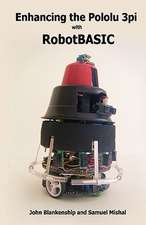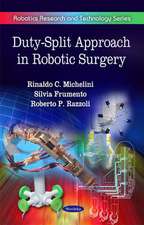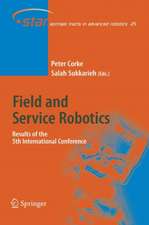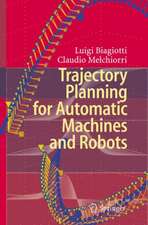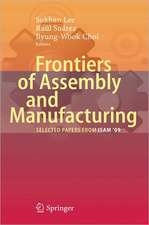Soft Robotics: Transferring Theory to Application
Editat de Alexander Verl, Alin Albu-Schäffer, Oliver Brock, Annika Raatzen Limba Engleză Hardback – 14 apr 2015
At present, a new discipline is emerging in this area, called »Soft Robotics«. It particularly challenges the traditional thinking of engineers, as the confluence of technologies, ranging from new materials, sensors, actuators and production techniques to new design tools, will make it possible to create new systems whose structures are almost completely made of soft materials, which bring about entirely new functions and behaviors, similar in many ways to natural systems.
These Proceedings focus on four main topics:
• Soft Actuators and Control
• Soft Interactions
• Soft Robot Assistants: Potential and Challenges
• Human-centered »Soft Robotics«.
| Toate formatele și edițiile | Preț | Express |
|---|---|---|
| Paperback (1) | 944.67 lei 6-8 săpt. | |
| Springer Berlin, Heidelberg – 13 oct 2016 | 944.67 lei 6-8 săpt. | |
| Hardback (1) | 945.13 lei 6-8 săpt. | |
| Springer Berlin, Heidelberg – 14 apr 2015 | 945.13 lei 6-8 săpt. |
Preț: 945.13 lei
Preț vechi: 1152.60 lei
-18% Nou
Puncte Express: 1418
Preț estimativ în valută:
180.87€ • 196.40$ • 151.93£
180.87€ • 196.40$ • 151.93£
Carte tipărită la comandă
Livrare economică 22 aprilie-06 mai
Preluare comenzi: 021 569.72.76
Specificații
ISBN-13: 9783662445051
ISBN-10: 3662445050
Pagini: 291
Ilustrații: VIII, 291 p. 100 illus.
Dimensiuni: 155 x 235 x 20 mm
Greutate: 0.59 kg
Ediția:2015
Editura: Springer Berlin, Heidelberg
Colecția Springer
Locul publicării:Berlin, Heidelberg, Germany
ISBN-10: 3662445050
Pagini: 291
Ilustrații: VIII, 291 p. 100 illus.
Dimensiuni: 155 x 235 x 20 mm
Greutate: 0.59 kg
Ediția:2015
Editura: Springer Berlin, Heidelberg
Colecția Springer
Locul publicării:Berlin, Heidelberg, Germany
Public țintă
ResearchCuprins
Sensors and Actuators.- Simulation, Modeling and Control.- Design, Materials and Manufacturing.- Soft Robotics Applications.
Textul de pe ultima copertă
The research areas as well as the knowledge gained for the practical use of robots are growing and expanding beyond manufacturing and industrial automation, making inroads in sectors such as health care and terrain sensing, as well as general assistive systems working in close interaction with humans. In a situation like this, it is necessary for future robot systems to become less stiff and more specialized by taking inspiration from the mechanical compliance and versatility found in natural materials and organisms.
At present, a new discipline is emerging in this area, called »Soft Robotics«. It particularly challenges the traditional thinking of engineers, as the confluence of technologies, ranging from new materials, sensors, actuators and production techniques to new design tools, will make it possible to create new systems whose structures are almost completely made of soft materials, which bring about entirely new functions and behaviors, similar in many ways to natural systems.
These Proceedings focus on four main topics:
• Soft Actuators and Control
• Soft Interactions
• Soft Robot Assistants: Potential and Challenges
• Human-centered »Soft Robotics«.
At present, a new discipline is emerging in this area, called »Soft Robotics«. It particularly challenges the traditional thinking of engineers, as the confluence of technologies, ranging from new materials, sensors, actuators and production techniques to new design tools, will make it possible to create new systems whose structures are almost completely made of soft materials, which bring about entirely new functions and behaviors, similar in many ways to natural systems.
These Proceedings focus on four main topics:
• Soft Actuators and Control
• Soft Interactions
• Soft Robot Assistants: Potential and Challenges
• Human-centered »Soft Robotics«.
Caracteristici
Overview of current developments in the emerging field of Soft Robotics A novel approach in robotics Written by experts in the field Includes supplementary material: sn.pub/extras

